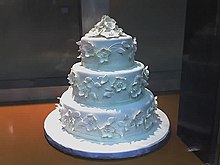
Confectionery is the art of making confections, which are food items that are rich in sugar and carbohydrates. Exact definitions are difficult. In general, however, confectionery is divided into two broad and somewhat overlapping categories: bakers' confections and sugar confections. The occupation of confectioner encompasses the categories of cooking performed by both the French patissier and the confiseur.

Cake is a flour confection made from flour, sugar, and other ingredients and is usually baked. In their oldest forms, cakes were modifications of bread, but cakes now cover a wide range of preparations that can be simple or elaborate and which share features with desserts such as pastries, meringues, custards, and pies.
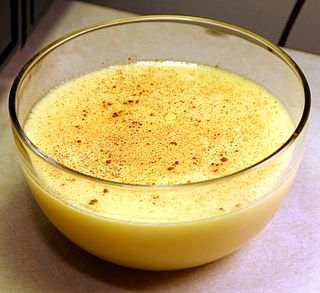
Custard is a variety of culinary preparations based on sweetened milk, cheese, or cream cooked with egg or egg yolk to thicken it, and sometimes also flour, corn starch, or gelatin. Depending on the recipe, custard may vary in consistency from a thin pouring sauce to the thick pastry cream used to fill éclairs. The most common custards are used in custard desserts or dessert sauces and typically include sugar and vanilla; however, savory custards are also found, e.g., in quiche.
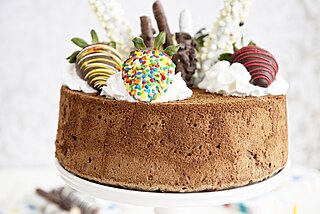
Angel food cake, or angel cake, is a type of sponge cake made with egg whites, flour, and sugar. A whipping agent, such as cream of tartar, is commonly added. It differs from other cakes because it uses no butter. Its aerated texture comes from whipped egg white. Angel food cake originated in the United States and first became popular in the late 19th century. It gained its unique reputation along with its name due to its light and fluffy texture and white color.

Pound cake is a type of cake traditionally made with a pound of each of four ingredients: flour, butter, eggs, and sugar. Pound cakes are generally baked in either a loaf pan or a Bundt mold. They are sometimes served either dusted with powdered sugar, lightly glazed, or with a coat of icing.

Shortbread or shortie is a traditional Scottish biscuit usually made from one part white sugar, two parts butter, and three to four parts plain wheat flour. Shortbread does not contain any leavening, such as baking powder or baking soda. Shortbread is widely associated with Christmas and Hogmanay festivities in Scotland, and some Scottish brands are exported around the world.

Devil's food cake is a moist, rich chocolate layer cake.

A layer cake or sandwich cake is a cake consisting of multiple stacked sheets of cake, held together by frosting or another type of filling, such as jam or other preserves. Most cake recipes can be adapted for layer cakes; butter cakes and sponge cakes are common choices. Frequently, the cake is covered with icing, but sometimes, the sides are left undecorated, so that the filling and the number of layers are visible.

Hot milk cake is a butter sponge cake from American cuisine. It can be made as a sheet cake or a layer cake, or baked in a tube pan. The hot milk and butter give the cake a distinctive fine-grained texture, similar to pound cake.
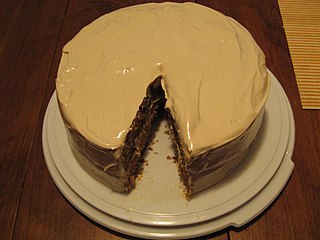
Spice cake is a type of cake that is traditionally flavored with a mixture of spices. The cake can be prepared in many varieties. Predominant flavorings include spices such as cinnamon, cloves, allspice, ginger, and nutmeg.

A génoise, also known as Genoese cake or Genovese cake, is a French sponge cake named after the city of Genoa and associated with French cuisine. It was created by François Massialot in the late 17th century. Instead of using chemical leavening, air is suspended in the batter during mixing to provide volume.

Lane cake, also known as prize cake or Alabama Lane cake, is a bourbon-laced baked cake traditional in the American South. It was invented or popularized by Emma Rylander Lane (1856-1904), a native and long-time resident of Americus, Georgia, who developed the recipe while living in Clayton, Alabama, in the 1890s. She published the original recipe in Some Good Things to Eat (1898). Her original recipe included 8 egg whites, 1 cup butter, 1 cup sweet milk, 2 cups sifted sugar, 3 ¼ cups sifted flour, 2 teaspoons baking powder, 1 tablespoon vanilla and called for the layers to be baked in pie tins lined with ungreased brown paper rather than in cake pans. The filling called for 8 egg yolks, 1 cup of sugar, 1/2 cup butter, 1 cup seeded raisins, 1 wine-glass of whiskey or brandy, and 1 teaspoon vanilla.

A bombe glacée, or simply a bombe, is a French ice cream dessert frozen in a spherical mould so as to resemble a cannonball, hence the name ice cream bomb. Escoffier gives over sixty recipes for bombes in Le Guide culinaire. The dessert appeared on restaurant menus as early as 1882.

Angel cake is a type of layer cake that originated in the United Kingdom, and first became popular in the late 19th century.
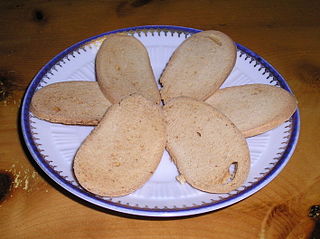
Baicoli are Italian biscuits, originating in the city of Venice. They are made with sugar, butter, flour, yeast, eggs, and salt.

Sponge cake is a light cake made with eggs, flour and sugar, sometimes leavened with baking powder. Some sponge cakes do not contain egg yolks, like angel food cake, but most of them do. Sponge cakes, leavened with beaten eggs, originated during the Renaissance, possibly in Spain. The sponge cake is thought to be one of the first non-yeasted cakes, and the earliest attested sponge cake recipe in English is found in a book by the English poet Gervase Markham, The English Huswife, Containing the Inward and Outward Virtues Which Ought to Be in a Complete Woman (1615). Still, the cake was much more like a cracker: thin and crispy. Sponge cakes became the cake recognised today when bakers started using beaten eggs as a rising agent in the mid-18th century. The Victorian creation of baking powder by English food manufacturer Alfred Bird in 1843 allowed the addition of butter to the traditional sponge recipe, resulting in the creation of the Victoria sponge. Cakes are available in many flavours and have many recipes as well. Sponge cakes have become snack cakes via the Twinkie.

Brazo de Mercedes is a traditional Filipino meringue roll with a custard filling typically dusted with powdered sugar. It is a type of pianono.

Crème brûlée or crème brulée, also known as burnt cream or Trinity cream, and virtually identical to crema catalana, is a dessert consisting of a rich custard base topped with a layer of hardened caramelized sugar. It is normally served slightly chilled; the heat from the caramelizing process tends to warm the top of the custard, while leaving the center cool. The custard base is generally flavored with vanilla in French cuisine, but can have other flavorings. It is sometimes garnished with fruit.
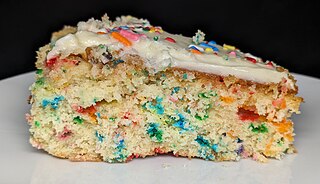
Confetti cake is a type of cake that has rainbow colored sprinkles baked into the batter. It is called confetti cake because when baked, the rainbow sprinkles melt into dots of bright color that resemble confetti. Typically the batter is either white, golden, or yellow to allow for a better visual effect; but chocolate, devil’s food, and strawberry cake variations also exist. The cake generally consists of flour, butter, baking powder, salt, sugar, vegetable oil, eggs, vanilla extract, milk, and rainbow colored sprinkles. The cake normally has a frosting made of butter, salt, powdered sugar, vanilla extract, and milk.
Amygdalopita is an almond cake in Greek cuisine made with ground almonds, flour, butter, eggs and pastry cream. It is one of the most common glyka tapsiou - dessert dishes like pies and breads baked in baking pans. Other common desserts of this style are galaktoboureko, karydopita and kadaifi.







